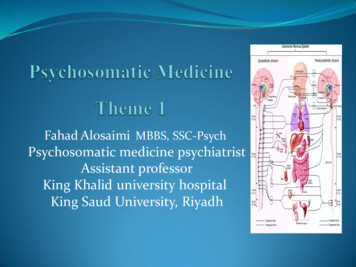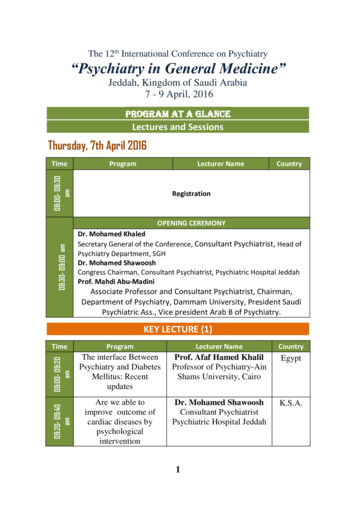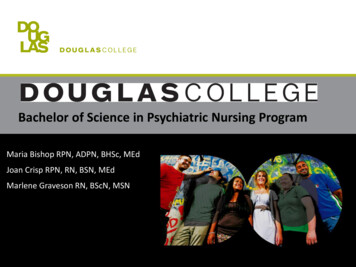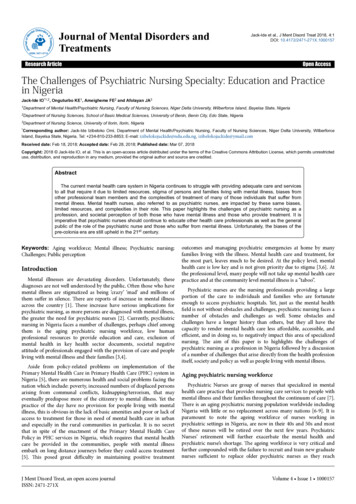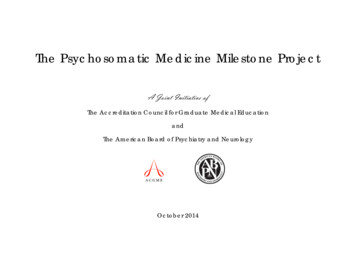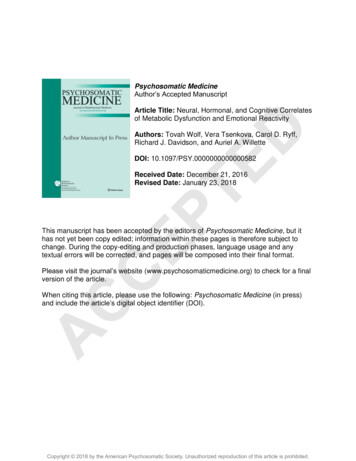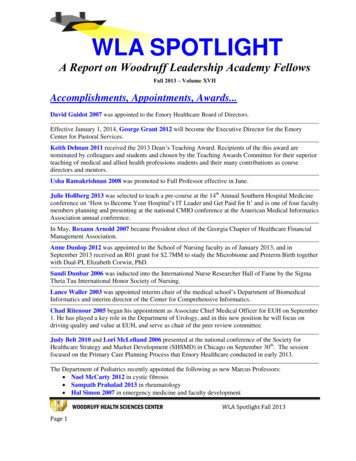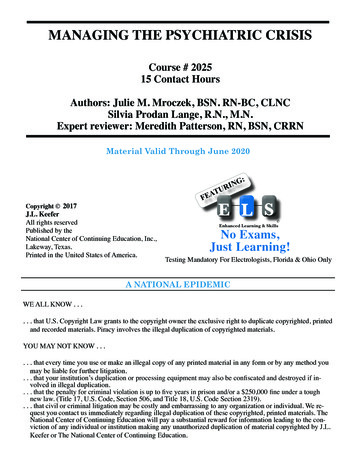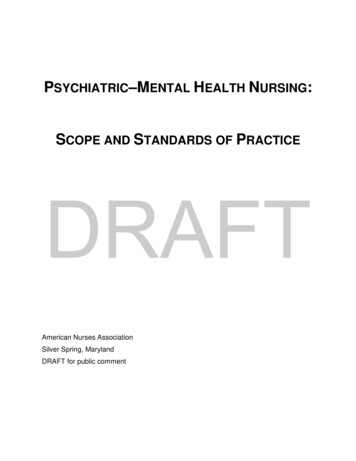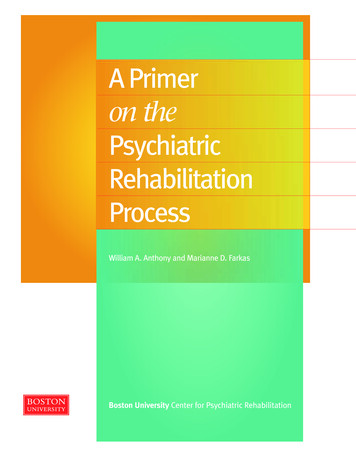
Transcription
Eur. J. Psychiat. Vol. 20, N. 3, (165-171)2006Key words: Psychosomatic medicine, Subspecialty, Liaison psychiatry.Psychosomatic medicine: A new psychiatricsubspecialty in the U.S. focused on the interfacebetween psychiatry and medicineConstantine G. Lyketsos, MD, MHS*,Frits J. Huyse, MD, PhD**,David F. Gitlin, MD***,James L. Levenson, MD***** Division of Geriatric Psychiatry andNeuropsychiatry, Department of Psychiatryand Behavioral Sciences, School ofMedicine, The Johns Hopkins University** Department of Internal, Medicine,University Medical Center Groningen,Groningen, The Netherlands*** Department of Psychiatry, Brigham andWomen’s Hospital, Harvard UniversityMedical School, Boston, Massachusetts**** Department of Psychiatry, School ofMedicine, Virginia CommonwealthUniversity, Richmond, VirginiaUSAABSTRACT – Background and Objectives: In the past, Psychosomatic Medicine (PM)has had ambiguous connotations, and there have been many other names for this specialized fields, including Consultation-Liaison Psychiatry. The objective of this report is tobriefly review the background, the history and current status of PM, which recently wasrecognized in the U.S. a psychiatric subspecialty.Methods: Historical review and review of the literature.Results: PM has a rich history. Psychoanalysts and psychophysiologists pioneered thestudy of mind-body interactions, and crucial events in the development include the funding of PM units in several U.S. teaching hospitals by the Rockefeller Foundation, and thetraining grants and a research development program funded by the National Institute ofMental Health. By the 1980s, all psychiatry residency programs were requiered to providesubstancial clinical experience in the field, and as of 2005 there were 32 fellowship programs in the Academy of Psychosomatic Medicine's (APM) directory. In 2001, The Academy of Psychosomatic Medicine (APM) applied for the recognition of PM as a subspecialty of psychiatry, and formal approval was granted by the American Board of MedicalSpecialties (ABMS) in March 2003.
166 C. LYKETSOS ET AL.The foundation of PM is a specialized body of scientific knowledge regarding psychiatric aspects of medical illness. This has been articulated in contemporary textbooks, journals and regular scientificic meetings of national and international societies A cadre ofscholars and researchers has emerged, and important contributions have occurred. A majorgoal of the PM field is to improve the psychiatric care of patients with complex medicalconditions. There are a number of obstacles and challenges ahead in pursuing optimalintegration of PM services into existing service delivery systems of care, but anticipatedexpansion of accredited fellowship programs in PM will hopefully help address this shortfall. In the past 20 years an international PM network has developed with increasing scientific exchanges, and the US paradigm is regarded as important for the development ofPM as a subspecialty internationally.Conclusion: Formal recognition as a subspecialty in the U.S. has and will strengthenPM and will enhance its growth internationally.Received 19 November 2005Accepted 1 February 2006IntroductionIn the past, Psychosomatic Medicine (PM)has had ambiguous connotations, alternatively “psychogenic” or “holistic,” but it is thelatter meaning that has characterized itsemergence as a contemporary scientific andclinical discipline1. PM is the newest psychiatric subspecialty approved by the AmericanBoard of Medical Specialties. There havebeen many other names for this specializedfield, including Consultation-Liaison psychiatry2, medical-surgical psychiatry, psychological medicine, or psychiatric care of thecomplex medically ill. The name chosen forthe field was intended to reflect the field’shistory, its focus on the interface betweenpsychiatry and other areas of medicine, andthe patient population it serves. PM psychiatrists have special expertise in the diagnosisand treatment of psychiatric conditions incomplex medically ill patients3. Workingclosely with physicians in primary care andother specialties, its practitioners treat andstudy four general groups of patients, sometimes referred to as the “complex medicallyill”: those with co-morbid psychiatric andgeneral medical illnesses complicating eachother’s management; those with psychiatricdisorders that are the direct consequence of aprimary medical condition or its treatment,such as delirium, dementia or other secondary mental disorders (formerly known as“organic” disorders); those with complex illness behavior such as “somatoform” andfunctional disorders; and, patients with acutepsychopathology admitted to medical-surgical units, such as after attempted suicide.Many of these patients have multiple medical, psychiatric, functional, and/or substanceabuse disorders, thus are best thought of asthe psychiatric counterpart of the multimorbid frail elderly seen by geriatricians.PM psychiatrists have been trained todeliver services in the general health caresector working with the complex medicallyill. They have been known as consultationliaison psychiatrists practitioners. Theymay work as hospital-based consultationliaison psychiatrists, on medical-psychiatric inpatient units4, and in settings inwhich mental health services are integratedwith primary care or medical specialties.Thus the field’s name reflects the fact thatit exists at the interface of psychiatry andmedicine and focuses on the interactionbetween medical conditions and psychi-
PSYCHOSOMATIC MEDICINE: A NEW PSYCHIATRIC SUBSPECIALTY IN THE U.S. 167atric disorders. The rest of this article isdevoted to a brief discussion of the historyand current status of PM.HistoryPM has a rich history. The term "psychosomatic” was introduced by Johann Heinroth in 1818, and “psychosomatic medicine"by Felix Deutsch around 19225. Psychoanalysts and psychophysiologists pioneered thestudy of mind-body interactions from verydifferent vantage points, each contributing tothe growth of PM as a clinical and scholarlyfield. The modern history of the field perhaps starts with the Rockefeller Foundation’s funding of PM units in several U.S.teaching hospitals in 1935. The NationalInstitute of Mental Health made it a priorityto foster the growth of consultation-liaisonpsychiatry, the name of the field at the time,through training grants (circa 1975) and aresearch development program (circa 1985).The integration of consultation-liaisonpsychiatry into the core of psychiatric residency training began in the 1960s at individual institutions. By the 1980s, all psychiatry residency programs were required toprovide substantial clinical experience inthe field. In the U.S., subspecialty fellowship training in PM has been available forover 25 years, with over 1,000 psychiatristseducated in this subspecialty. As of 2005,there were 32 fellowship programs in theAcademy of Psychosomatic Medicine’s(APM) directory. In the last national surveyof U.S. psychiatrists’ practices, well over2,500 psychiatrists were practicing in thisfield6.In 2001, The Academy of PsychosomaticMedicine (APM) applied to the AmericanBoard of Psychiatry and Neurology (ABPN)for the recognition of "Psychosomatic Medicine” as a subspecialty of psychiatry, choosing to return to the name for the field imbedded in its history, its journals, and itsnational organizations7. Formal approvalwas granted by the American PsychiatricAssociation, the ABPN, the ResidencyReview Commission (RRC) of the Accreditation Committee for Graduate MedicalEducation (ACGME), and eventually theAmerican Board of Medical Specialties(ABMS), the latter in March 2003. The firstcertifying examination was administered inJune 2005 to almost 500 psychiatrists. As ofAugust 2005, the ACGME has accredited 16fellowship-training programs in PM.An impediment to the field’s growth hasbeen the split between general medical andmental healthcare, with major adverseeffects on quality of medical service deliveryand patient oriented care8. This split isreflected in disparities and disintegration inthe reimbursement of patient care (carveouts, lack of parity in coverage) and fundingmechanisms in silos that do not promotecross-disease research and therefore requirespecial attention for the further growth ofPM.Psychosomatic medicine as ascholarly disciplineThe foundation of PM is a specializedbody of scientific knowledge regarding psychiatric aspects of medical illness. This hasbeen articulated in half a dozen contemporary textbooks, about a dozen active journals, and the regular scientific meetings of adozen national and international societies2.A major new textbook for the field hasrecently been published and is being widely
168 C. LYKETSOS ET AL.used9. A cadre of scholars and researchershas emerged involved in a wide spectrum ofinvestigations looking at the medical illness-psychiatry interface. Important contributions have occurred in the interfacebetween psychiatry and HIV-AIDS, cancer,transplantation, cardiology, neurology,endocrinology, pulmonary, renal and GI diseases, obstetrics-gynecology, and geriatricmedicine.Epidemiologic research has repeatedlydocumented a substantial clustering ofmedical and psychiatric morbidity, especially in the complex medically ill. Thisco-morbidity leads to increased mortality,morbidity, loss of quality of life and excessutilization of health care services throughseveral psychosocial and biological mechanisms, among them non-compliance andlack of interdisciplinary communication.Studies in the 1980s and 90s identified theextent and nature of psychiatric morbidityassociated with the most common diseases,and its effects on outcomes such as mortality, morbidity, quality of life and excesshealth care utilization2. These studiesestablished the high prevalence rates of abroad range of psychiatric disorders inmedical illnesses as well as less common,or newly recognized psychopathologicconditions. Similar studies examined psychiatric morbidity in patients with abnormal illness behavior such as unexplainedphysical complaints and functional disorders. Inpatients in general hospitals havethe highest rates of psychiatric disordersfollowed by medical outpatients2. Compared to community samples, depressivedisorders in the general hospital are 2-5times as common, substance abuse 2 to 3times as common, and somatoform disorders more than 10 times as common2.Delirium occurs in almost a fifth of elderlymedical inpatients2. The impact of psychi-atric illness on medical morbidity is substantial. For example, depression has beenassociated with increased risk of recurrence and mortality from myocardialinfarction2, increased risk of stroke inhypertensive patients2, worse glycemiccontrol in diabetic patients2, and increasedfunctional dependency in Alzheimerpatients2. In fact, psychiatric morbidity inmany medical disorders has been shown tobe a potent risk factor for increased medical morbidity and disability. Unfortunately, many studies demonstrate that potentially treatable psychiatric disorders in thecomplex medically ill are typically underdiagnosed and under-treated2, 6,8.Early empirical efforts to treat psychiatricmorbidity in the medically ill have been followed by intervention trials focused onreducing their associated impact on medicalillness such as in cardiac and diabetespatients2. In these studies the psychiatriccondition is treated, while its effects onmedical outcomes, compliance with treatment for the medical condition, and qualityof life are assessed. Similar trials are underway for patients with unexplained symptoms and related “functional” syndromes.Research has also begun to explore thecomplex mechanisms involved in the development of psychiatric morbidity in the medically ill, including genetic, neurochemical,behavioral or social factors, the latterincluding the way health care is delivered.Examples include the relationship betweenthe location of stroke and major depression,the role of childhood sexual abuse in chronic pain and illness behavior, interferoninduced depression, causal pathways todelirium, and barriers to care for bloodborne diseases among patients with seriousmental illness2,10.
PSYCHOSOMATIC MEDICINE: A NEW PSYCHIATRIC SUBSPECIALTY IN THE U.S. 169The clinical practice ofPsychosomatic Medicine:models for service deliveryA major goal of the PM field is toimprove the psychiatric care of patientswith complex medical conditions. Physicians in primary care or internal medicineprovide the great majority of the psychiatric care for these patients. These patientsare encountered in general or chronic carehospitals, in home healthcare settings, inthe offices of primary care or specialistphysicians, and in many other health careenvironments, such as rehabilitation units,nursing homes, and assisted living facilities. The higher concentration of patientswith psychiatric disorders in the generalhospital and in primary care provides acritical opportunity, working closely withteam members in other medical specialties,to identify and treat this important group ofpatients both to reduce their emotional suffering and improve their medical outcomes. Patients who pass through theseportals need recognition, appropriate diagnosis, initiation of treatment, and referralfor the follow-up psychiatric care theywould otherwise fail to receive11. Failuresto identify, evaluate, diagnose, treat, orachieve symptom resolution results in preventable adverse outcomes. A major causeof the failure to identify and treat psychiatric disorders in the medical setting is theabsence of on-site or ready access to psychiatric expertise. PM subspecialists deliver emergency services for attempted suicide and serious behavioral disturbances;consults for medical generalists and specialists, and most critically, integrated services for patients with psychiatric disorders and complex medical illness. When anactive PM service is integrated with themedical/surgical staff in collaborative pro-grams to identify and initiate treatment forpsychiatric disorders, there is potential forgreat improvement in both psychiatric andmedical outcomes2.There are a number of obstacles and challenges ahead in pursuing optimal integration of PM services into existing servicedelivery systems of care. Most PM psychiatrists are on psychiatric consultation services,rarely found outside teaching hospitals, andtheir services are reactive, typically emergentor urgent. Optimal care for patients withcomplex medical illnesses such as cancer orAIDS, or for those patients being consideredfor transplant or gastric bypass, calls forclose working relationships with the primaryphysicians as well as easy access to specialized psychiatric expertise. Psychiatric liaison, in which psychiatrists are integratedmembers of a specialized care team, is amore advanced model, with greater ability toprovide early detection and prevention10.However, such services are usually limitedto larger teaching and specialty hospitals.Thus, there is an overall shortage of PMpsychiatrists in the U.S., and they are notevenly distributed, but anticipated expansion of accredited fellowship programs inPM will hopefully help address this shortfall.Psychosomatic Medicine’sInterface with other medicaldisciplinesTraining of other medical specialists: PMpsychiatrists often take part in the training ofnon-psychiatric residents, particularly ininternal medicine, family practice, pediatrics,obstetrics/gynecology, and neurology. Theyplay a significant role in teaching about psychiatric disorders at annual meetings of the
170 C. LYKETSOS ET AL.American College of Physicians, the Societyfor General Internal Medicine, the AmericanAssociation for Family Practice, the American College of Obstetrics and Gynecology,and others. An important aspect is the combined training of psychiatrists and other medical specialists, in “medicine-psychiatry”inpatient units, collaborative care outpatientclinics, or in other integrated service deliveryapproaches.Participation in medical center ethicscommittees: PM psychiatrists play leadingroles on medical center ethics committees,contributing specialized expertise regardingend of life decisions, capacity/competency,involuntary treatment, boundary violations,and other doctor-patient relationship problems. PM psychiatrists have served as chairsof hospital ethics committees far out of proportion to their numbers (Academy of Psychosomatic Medicine Task Force on Ethics,unpublished data).International developmentsIn the past 20 years an international PMnetwork has developed with increasing scientific exchanges. The US paradigm isregarded as important for the developmentof PM as a subspecialty internationally. InAustralia, the United Kingdom and Japanformal criteria for sub-specialty status inPM have recently been established. InTurkey it is in process of evaluation. Inother countries subspecialty status is a moredistant prospect. For instance, in Spain PMis a rotation in the basic psychiatric specialty training, whereas in the Netherlandsunder the influence of the US developments, such a rotation has become a realisticpossibility. It is important to know that inGermany, where psychiatrists do the major-ity of consultations in the general hospital,specialists in PM are primarily internistswho treat patients with depression or abnormal illness behavior in specialized PMdepartments with a primary focus on psychotherapy. German patients with “organic”psychosis, substance abuse, or attemptedsuicide are treated by general psychiatrists.Although German psychiatrists providehospital consultations, this is not a subspecialty within their field.ConclusionPM has evolved from its beginnings inpsychophysiology and psychoanalysis tobecome a subspecialty of psychiatry devoted to psychiatric care of the complex medically ill through consultation and integration with the rest of medicine. The futureaims of the PM field include: Collaboration with other medical specialties and disciplines to develop integratedcare for the complex medically ill thus overcoming the burden of fragmentation in theexisting service delivery system; Development of combined training programs for medical specialists in integratedcare on psychiatry-medicine units and othertypes of integrated service delivery; Development, funding, and evaluationof new collaborative research models inpsychopathology and complex medical illnesses; Changes in health care insurance andfinancing to overcome the current disintegration and disparities between mentalhealth and general health care.Formal recognition as a subspecialty in theU.S. has and will strengthen PM and will
PSYCHOSOMATIC MEDICINE: A NEW PSYCHIATRIC SUBSPECIALTY IN THE U.S. 171enhance its growth internationally. The certification of more psychiatrists with expertisein PM will help address the unmet psychiatric needs of the medically ill, improve thequality of education and training both in psychiatry and in other areas of medicine, promote integrative research, and improve themedical outcomes of this complex patientpopulation. Progress in PM and its contributions to care are endangered by existing splitsand fragmentation in health care delivery andfinancing.6. Dorwart RA, Chartock LR, Dial T, Fenton W, Knesper D, Koran LM, et al. A national study of psychiatrists'professional activities. Am J Psychiatry 1992; 149: 14991505.7. Lyketsos, CG, Levenson JL, with the Academy of Psychosomatic Medicine (APM) Task Force for Subspecialization. Proposal for recognition of “Psychosomatic Medicine”as a psychiatric subspecialty. Academy of PsychosomaticMedicine, July 2001.8. Institute of Medicine. Crossing the quality chasm: anew health system for the 21st century. Committee onQuality of Health Care in America. Washington DC:National Academy Press; 2001.9. Levenson JL (Editor). Textbook of PsychosomaticMedicine. Washington DC: American Psychiatric PressInc; 2004.References1. Lipowski ZJ. What does the word "psychosomatic"really mean? A historical and semantic inquiry. PsychosomMed 1984; 46: 153-171.2. Kornfeld DS. Consultation-Liaison psychiatry: contributions to medical practice. Am J Psychiatry 2002; 159:1964-1972.3. Gitlin DF, Levenson JL, Lyketsos CG. Psychosomatic Medicine: A New Psychiatric Subspecialty. AcademicPsychiatry 2004; 28: 4-11.4. Kishi Y, Kathol RG. Integrating medical and psychiatric treatment in an inpatient medical setting. The type IVprogram. Psychosomatics 1999; 40(4): 345-355.5. Lipsitt DR. Consultation-liaison psychiatry and psychosomatic medicine: the company they keep. PsychosomMed 2001; 63: 896-909.10. Rosenberg S, Brunette M, Oxman T, Marsh B,Dietrich A, Mueser K, Drake R, Torrey W, Vidaver R.TheSTIRR model of best practices for blood-borne diseasesamong clients with serious mental illness. Psychiatr Serv2004; 55(6): 660-664.11. Huyse FJ. From consultation to complexity of careprediction and health service needs assessment. J Psychosomatic Res 1997; 43: 233-240.Address for correspondence:Constantine G. Lyketsos, MD, MHSProfessor of Psychiatry550 North Broadway, Suite 308Baltimore, MD 21207410-955-6158 (tel)410-614-8042 (fax)kostas@jhmi.eduUSA
Academy of Psychosomatic Medicine's (APM) directory. In the last national survey of U.S. psychiatrists' practices, well over 2,500 psychiatrists were practicing in this field6. In 2001, The Academy of Psychosomatic Medicine (APM) applied to the American Board of Psychiatry and Neurology (ABPN) for the recognition of "Psychosomatic Medi-
